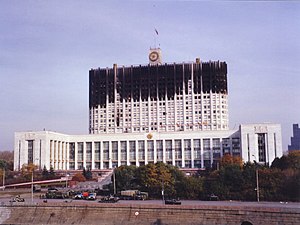| ||
|---|---|---|
|
First term
Second term Post-Presidency |
||
In September and October 1993, a constitutional crisis arose in the Russian Federation from a conflict between the then Russian president Boris Yeltsin and the country's parliament. Yeltsin performed a self-coup, dissolving parliament and instituting a presidential rule by decree system. The crisis ended with Yeltsin using military force to attack Moscow's House of Soviets and arrest the lawmakers. In Russia, the events are known as the "October Coup" (Russian: Октябрьский путч, romanized: Oktyabr'skiy putch) or "Black October" (Russian: Чëрный октябрь, romanized: Chornyi Oktyabr').
Yeltsin assumed the presidency of the Russian Federation following the dissolution of the Soviet Union in 1991; the Soviet-era 1978 Russian constitution remained in effect. Yeltsin began assuming increasing powers, leading to a political standoff with Russia's parliament, which in 1993 was composed of the Congress of People's Deputies and the Supreme Soviet. After holding a four-part referendum in April on support for his leadership and socio-economical policies, as well as on support for early elections, Yeltsin called for parliamentary elections and dissolved the legislature on 21 September in a move not authorized by the constitution, nor approved by the referendum.
On 23 September, the parliament (led by Supreme Soviet Chairman Ruslan Khasbulatov) impeached Yeltsin, proclaimed vice president Alexander Rutskoy the acting president, and barricaded itself in the White House building. Ten days of street fighting commenced between police and demonstrators loyal to Yeltsin and the parliamentarians. On 3 October, demonstrators removed militia cordons around the parliament and, urged by their leaders, took over the mayor's offices and tried to storm the Ostankino television centre. On 4 October, the army, which had remained neutral, shelled the White House using tanks and stormed the building with special forces on Yeltsin's orders, arresting the surviving leaders of the resistance. All of those involved in the events were later granted amnesty by the State Duma in February 1994 and released from jail.
At the climax of the crisis, Russia was thought by some to be "on the brink" of civil war.[4][5] The 10-day conflict became the deadliest single event of street fighting in Moscow's history since the October Revolution;[6] 147 people were killed and 437 wounded according to the official Russian government statistics. In the wake of the events, Yeltsin consolidated his position, further expanded the powers of the executive, and pushed through the adoption of the 1993 constitution of the Russian Federation.
Cite error: There are <ref group=note> tags on this page, but the references will not show without a {{reflist|group=note}} template (see the help page).
- ^ "Russia's New Foreign Policy" (PDF). American Enterprise Institute for Public Policy Research. p. 5. Retrieved 10 February 2023.
Hence their wholehearted support for Yeltsin in his September–October 1993 confrontation with the Left-nationalist radical supporters of the Supreme Soviet. The Czech President Václav Havel said October 4 that the clashes in Moscow were not simply 'a power struggle, but rather a fight between democracy and totalitarianism.' In a joint statement Presidents Lennart Meri of Estonia, Guntis Ulmanis of Latvia, and Algirdas Brazauskas of Lithuania called the struggle in Moscow 'a contest between a democratically elected President and antidemocratic power structures.' Their Moldovan counterpart, Mircea Snegur, called the Supreme Soviet supporters 'Communist, imperialist forces who want to turn Russia into a concentration camp'. 'In my thoughts I am on the barricades with the defenders of Russian democracy, as I was next to them in August 1991,' Eduard Shevardnadze said in a message to the Kremlin on the late afternoon of October 3, 1993, when the outcome looked quite grim for Yeltsin. 'Deeply concerned about the events in Moscow, I am again expressing my resolute support for President Yeltsin and his allies.'
- ^ "Yeltsin Receives Widespread Backing for Assault". The Washington Post. 4 October 1993. Retrieved 23 June 2024.
- ^ "'Russian Revolution of October 1993' seen from office of Moldova's ambassador in Moscow. Op-Ed by Anatol Țăranu, ex-ambassador of Moldova to Russia". IPN press agency. 28 September 2023. Retrieved 22 January 2024.
Unlike Chisinau, the leaders of the Transnistrian separatists supported almost openly the Rutskoy-Khasbulatov camp, sending paramilitaries from Transnistria to the Russian capital to defend the White House. On October 4, the Moldovan ambassador in Moscow gave an interview for the Russian press, in which he warned about the presence of representatives of paramilitary detachments of the Transnistrian separatists among the defenders of the White House.
- ^ "Remembering Russia's civil siege". Retrieved 10 March 2003.
- ^ "Putin is part of a continuum that stretches back to the tsars". TheGuardian.com. 4 April 2017. Retrieved 4 April 2017.
- ^ Braithwaite, Rodric (2011). Afgantsy: the Russians in Afghanistan 1979–89. Profile Books. p. 312. ISBN 978-1-84668-054-0.
Cite error: There are <ref group=lower-alpha> tags or {{efn}} templates on this page, but the references will not show without a {{reflist|group=lower-alpha}} template or {{notelist}} template (see the help page).


